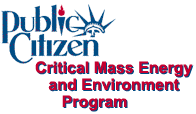
Radioactive Roads and Rails
Yucca
Mountain
Background
Information
What is high-level nuclear waste?
High-level radioactive waste is produced at commercial nuclear power plants and at nuclear materials production defense facilities. Nuclear fuel is made of solid pellets of enriched uranium. The pellets are sealed in tubes, which are bundled together to form a nuclear fuel assembly. The assemblies are put inside a nuclear reactor and used to generate heat to make electricity. The fuel will be used until it is spent or no longer efficient in generating heat. Once a year, approximately one-third of the nuclear fuel inside a reactor is removed and replaced by new fuel assemblies. The used fuel, called spent fuel (i.e., nuclear waste), is highly radioactive and is the primary form of high-level nuclear waste.
When spent fuel is removed from a reactor, it is extremely hot, so all reactors have "spent fuel pools," where tubes of spent fuel are placed in order to cool and allow some of the radioactivity to decay. Each reactor is allotted only a certain amount of pool space, and when the pools are full, the reactors either must shut down or store some of the cooled spent fuel above ground on site, in concrete or steel containers called dry casks. When the spent fuel is moved into dry cask storage, it is still highly radioactive.
Why Yucca Mountain?
On-site storage of nuclear waste is very expensive. The nuclear industry has never been expected by the government to figure out what to do with the waste. Rather, the government has accepted responsibility. Past claims that nuclear energy would be "too cheap to meter" have been proven false. Instead, nuclear power plants add fees to their ratepayers’ bills for spent fuel storage and for the Nuclear Waste Fund, established by the federal government in 1982 to research ways to dispose of nuclear waste. The money in this fund is being used to pay for activities at Yucca Mountain, located near Las Vegas.
Yucca Mountain is the only site being considered by the Department of Energy (DOE) as a "permanent disposal" site for the United States’ high-level nuclear waste. The DOE is now in the final stages of a "site characterization" phase, which means that it is completing tests at the Yucca Mountain site to determine whether it is a suitable site for the disposal of radioactive waste. If the DOE determines that the site is acceptable, it will apply for a license from the Nuclear Regulatory Commission (NRC). If the license is granted, construction will begin. If all goes according to the DOE’s plan, waste will be accepted at Yucca Mountain beginning in 2010 and will continue to arrive at Yucca Mountain for at least 24 years, with the final "emplacement" activities ending after 2035.
By law, a Yucca Mountain repository would be designed to contain 70,000 metric tons of waste, including 63,000 metric tons of spent fuel from commercial reactors and 7,000 metric tons of DOE high-level waste. However, an estimated 107,500 metric tons of high-level waste will be in storage across the country by the time the repository would open. Because a Yucca Mountain repository could not accommodate all the waste projected to be produced, it is inaccurate to characterize the project as a proposal for nuclear waste consolidation.
Problems with the Yucca Mountain Project
Groundwater Contamination
The DOE talks about "disposing of" nuclear waste. But nuclear waste cannot be disposed of; it only can be stored. When stored, there is always the danger that radiation will escape.
The original concept of a geologic repository was for a site with "natural barriers" sufficient to contain nuclear waste throughout the 240,000 years that it remains dangerously radioactive. But the DOE is finding more and more problems with the natural barrier system at Yucca Mountain, and the agency appears to be scrambling to piece together an engineered barrier system instead. DOE's repository design proposals have been criticized by the Nuclear Waste Technical Review Board for the high and unquantified levels of uncertainty involved in extrapolating performance expectations for engineered barriers (i.e. waste storage canisters). Indeed, it now seems to be a question of when - not if - the waste from a Yucca Mountain repository would contaminate the surrounding environment.
A
freshwater aquifer lies beneath Yucca Mountain. If radioactive waste from a repository leaks, it would jeopardize the health of nearby residents, who depend on that aquifer as their sole source of drinking water. The National Academy of Sciences has identified the groundwater pathway as a significant pathway of exposure in the vicinity of the Yucca Mountain site. Although the U.S. Environmental Protection Agency (EPA) has proposed a standard to limit groundwater radiation pollution to 4 millirem (10 millirems is equivalent to one chest X-ray), a strong effort is being led by the nuclear industry to take the standard-setting authority away from the EPA and give it to the NRC. The NRC’s proposed radiation standard contains no specific groundwater standard. This lack of a standard, coupled with the DOE’s refusal to seriously and honestly characterize the impacts of groundwater contamination, can only lead to the deterioration one of our nation’s most precious resources.Earthquakes
Should an earthquake hit the Yucca Mountain area while nuclear waste is stored there, disastrous consequences could result. The groundwater table could rise, submersing the stored waste. Or the storage canisters themselves could break open. Also, portions of the mountain could collapse, restricting access to the broken canisters inside.
Nevada ranks third in the nation for current seismic activity (see maps below).
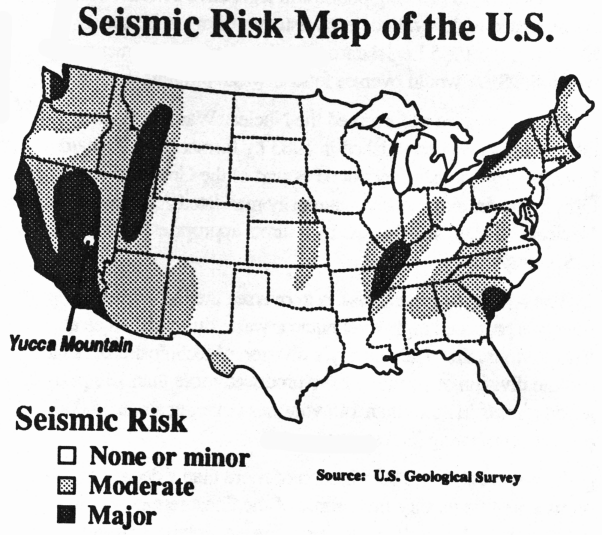
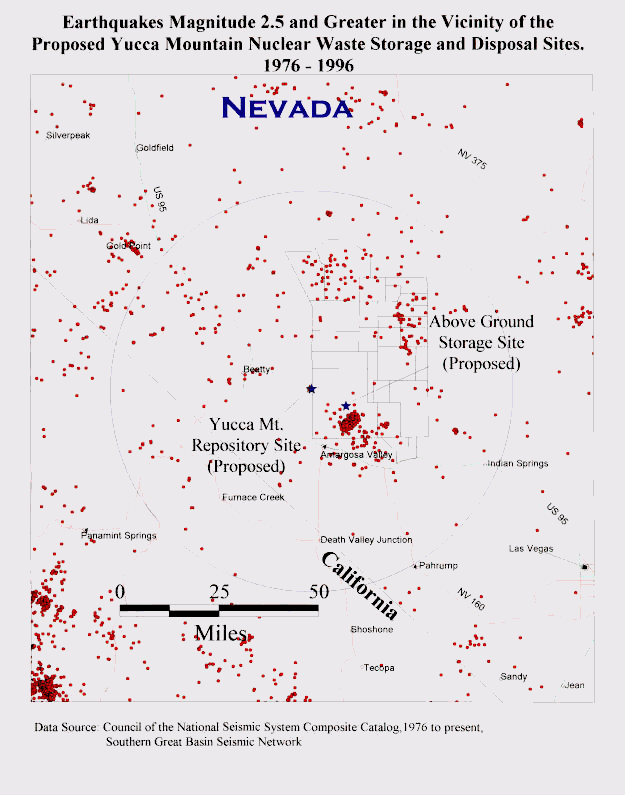
Since 1976, there have been more than 600 seismic events of a magnitude greater than 2.5 within a 50-mile radius of Yucca Mountain. Native Americans in the area call Yucca Mountain a rolling hill and speak of its constant movement. In 1992, an earthquake with a magnitude of 5.6 occurred that caused damage to a DOE field office building in the area. Further, some scientists believe that a significant rise in groundwater levels could occur as the result of an earthquake, possibly flooding the repository. This type of event would surely compromise the integrity of the nuclear waste containers and contaminate the groundwater beneath Yucca Mountain. Despite the evidence to the contrary, the DOE has said it considers it unlikely that an earthquake would strike the region.
Transporting High-level Radioactive Waste
High-level radioactive waste is currently located at 77 sites across the country and would have to be transported by truck or rail to Yucca Mountain if that site is approved as a geologic repository.
The DOE has not indicated whether it will transport the nuclear waste by truck or by train, but either way, the transportation will take at least 24 years and involve thousands of shipments. An analysis prepared by Clark County Comprehensive Planning Division in Nevada found that the waste would travel through 734 counties with a total population of 138 million people in 43 states. According to a 1997 survey conducted by Decision Research of Eugene, OR, 66.4 percent of Americans are opposed to shipping high-level radioactive waste to Nevada for temporary storage.
Although the DOE has refused to finalize the transportation routes it would use to haul this extremely hazardous material across the country, Department of Transportation regulations strictly limit the potential routes. Public Citizen teamed up with the state of Nevada’s Nuclear Waste Project Office to determine which routes would be most likely candidates for the transportation of nuclear waste. Maps and descriptions of these routes can be found at http://www.citizen.org/cmep by following the Atomic Atlas link. Subsequently, and while still refusing to propose a specific transportation plan, the DOE released its own set of maps showing potential shipment routes to Yucca Mountain. These can also be accessed online at http://www.ymp.gov/timeline/eis/routes/routemaps.htm.
Whether the waste is transported by truck or rail, it will be carried in transportation casks similar to the one pictured below. Current NRC regulations allow these casks to emit 10 millirems of radiation at two meters from the cask surface.
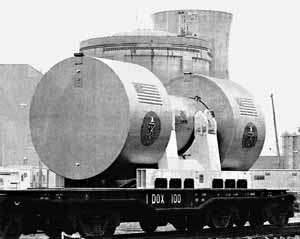
These casks have never been fully tested. The NRC sponsored a study in 1987 by the Lawrence Livermore National Laboratories. This study, commonly referred to as the "Modal Study," used computer modeling to predict cask responses to accident conditions. The study was inadequate in that it did not include full-scale physical testing of the casks, and the conditions that were used in the computer analysis did not represent real-life scenarios. The NRC has contracted with Sandia National Labs to conduct another study (the "Package Performance Study"), but this new study will not be completed until 2003 - long after a decision is to be made about Yucca Mountain.
Transporting nuclear waste poses inherent dangers, particularly in the event of an accident (e.g., if an equipment failure or human error causes the waste to roll off the truck or leak) or crash. It is unclear whether hospitals, police and rescue personnel along transportation routes would have the capacity to respond effectively to a nuclear waste emergency.
The DOE’s own estimates suggest that at least 50 accidents and as many as 310 accidents could occur during shipment of radioactive waste. As part of the 1986 Environmental Assessment for the Yucca Mountain repository site, the DOE conducted a study that found that a severe accident in a rural area involving a high-speed impact, lengthy fire and fuel oxidation would contaminate a 42-square-mile area, require 462 days to clean up and cost $620 million. The health, economic and environmental impacts of such an accident could devastate a community.
Transporting high-level nuclear waste to Yucca Mountain could cause other problems for communities en route. The potential for terrorist attacks on waste shipments has not been satisfactorily addressed in DOE's Yucca Mountain proposals. Also, property values have been shown to decline along nuclear waste transportation routes even without an accident or act of sabotage.
Although the Yucca Mountain Project would launch an unprecedented nuclear transportation scheme, the DOE's repository proposal and Draft Environmental Impact Statement deal inadequately with transportation issues. Yet, logically, the safety and viability of getting the waste to Nevada is an intrinsic aspect of considerations surrounding the repository proposal. It would therefore be premature at best for Congress to accept a Yucca Mountain site recommendation from DOE with so many questions relating to transportation unanswered.
Public Citizen advocates storing the waste on site at reactors, in pools or dry casks, until a satisfactory national solution to the nuclear waste problem is found. Leaving the waste on site has an added advantage; it allows for the natural decay of elements to lower the radiation and thermal heat content of the waste, thus making future transportation potentially less dangerous.
Roles of the Federal Government and Agencies
In addition to Congress, a number of agencies are involved in the development and implementation of a national nuclear waste policy. The chart below outlines the roles of Congress and the various agencies involved.
|
Congress |
Passed the Nuclear Waste Policy Act in 1982 and amendments in 1987, mandating DOE to evaluate the suitability of Yucca Mountain as a potential geologic repository for nuclear waste. Appropriates funds for agencies and for Yucca Mountain activities (Yucca Mountain funds come from the Nuclear Waste Fund, which includes fees collected from ratepayers). Will be asked to vote to override Nevada's objection if the state vetoes a favorable site recommendation from DOE. |
|
Nuclear Regulatory Commission (NRC) |
Regulates commercial nuclear activities by developing and enforcing regulations and issuing licenses. Developed procedures for licensing a high-level waste repository. Would be responsible for licensing nuclear waste storage at Yucca Mountain. Licenses transportation casks. Regulates "on-site" storage of nuclear waste at reactors. Commissioned Modal and Package Performance Studies to investigate the ability of transportation casks to withstand accident conditions. |
| Environmental Protection Agency (EPA) | Sets radiation protection standards. Proposed standards for a Yucca Mountain repository have been sent to the White House Office of Management and Budget (OMB) for interagency review. |
|
Department of Energy (DOE) |
Responsible for characterizing Yucca Mountain site and determining its suitability as a geologic nuclear waste repository. Currently finalizing Environmental Impact Statement for the Yucca Mountain Project. Scheduled to issue a site recommendation report to the President early this summer. Responsible for the construction, management and operation of the potential geologic repository at Yucca Mountain. Will take title to nuclear waste and transport it to Yucca Mountain if the repository is licensed. |
| Department of Transportation (DOT) | Ensures that waste carriers comply with routing regulations and guidelines. |
| Mine Safety and Health Administration of the Department of Labor (MSHA) | Responsible for ensuring the health and safety of underground workers at the Yucca Mountain facility. MSHA provides technical assistance and consultation services and conducts on-site safety and health visits at the facility. |
| Nuclear Waste Technical Review Board (NWTRB) | Created by Congress and appointed by the President. Reviews scientific and technical basis for DOE activities pertaining to the management and disposal of commercial high-level waste. |
| Critical Mass
Home Email Critical Mass |
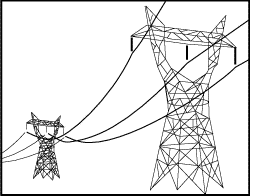 UTILITY DEREGULATION |
 NUCLEAR POWER & REACTOR SAFETY |
 RENEWABLE ENERGY |
 RADIOACTIVE WASTE POLICY |

|